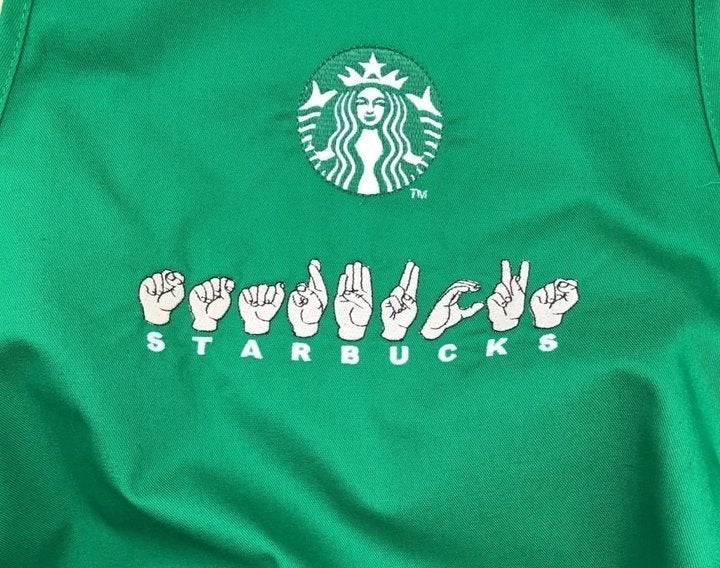
Back in March, my sister, who is deaf, was in line for lunch at a popular sandwich chain with two co-workers. Even though she has very understandable speech, she often types her order in her phone’s Notes app to make communication in situations like this as quick and easy as possible. So, there she was, in line, looking down at her phone and typing her order, when the woman to my sister’s left slapped her on the arm, really hard. My sister almost dropped her phone. The store employee behind the counter stood looking at her, rolling her eyes. Apparently, the employee had just said, loudly, to the entire store, “She needs to stop texting!” Being deaf, my sister didn’t hear this, hence the blow from the woman next to her in line. In response, my sister calmly held her phone up to the sandwich maker and showed what she had been typing ― her order. Both women were suitably chagrined, and the woman who had slapped my sister (ironically) signed, “I’m SO sorry.”
Unfortunately, stories like this are all too common in the deaf community.
So, to see that Starbucks is opening a store in the U.S. that can help prevent this kind of experience is wonderful news. And it’s wonderful for other reasons, as well. For example, for this “Signing Store Project,” Starbucks actively sought input from deaf consultants from the start. Besides integrating deaf people in the high-level planning of the project, Starbucks is working hard to integrate deaf culture within the store itself. The company is hiring 20 to 25 deaf and hard-of-hearing individuals to manage and run it. They consulted with deaf experts to ensure the store met design and architecture standards to maximize deaf access and comfort. They are purchasing special aprons from a deaf vendor, which have the fingerspelled letters for Starbucks embroidered across the front, and they also will feature artwork, coffee mug designs and pins designed by deaf artists. I applaud that a major U.S.-based corporate chain has so publicly dedicated itself to this kind of access.
As a HoH person, I’m thrilled. But there were a dozen pages of linked articles about this on Google, from CNN to Food & Wine. There was so much hype it was kind of absurd. Sure, it’s nice and all, but really? It’s just a Starbucks! My question when I saw this announcement all over the news was: Why is this such a huge story?
“Wouldn’t it be great if all Starbucks stores could have excellent communication access ― for all of their customers?”
The collective media orgasm sort of reminds me of when Paul McCartney released a video for his song, “My Valentine,” four years ago that instantly went viral, the one that had Natalie Portman and Johnny Depp using sign language. This was very “woke” on McCartney’s part, except for the fact that it wasn’t even comprehensible, in terms of actual American Sign Language. Depp’s stiff execution of signs along with his poker face unintentionally made the song, at least from a deaf point of view, hilarious. Depp knew he wasn’t seriously translating anything; he said, “I had to learn sign language and I was only copying what the guy showed me, so track him down.” Depp added: “But it was a gas ― sign language is apparently very interpretive. It’s all kind of different.″
The flippant attitude toward ASL demonstrated in Depp’s remarks is a pervasive phenomenon in our culture ― that is, the notion that sign language is “a gas.” It’s so “different,” something you throw in there to make things interesting. Do a little bit of signing with an exotic aquatic “other” and you win an Oscar. Have people sign in your appliance ad and people will say “Aw! So touching!”
There is a reason I have to throw at least a light sprinkling of cold water (or cold brew?) on this matter. While the actual Starbucks store opening is really good news for actual deaf people, I’d like to point out that maybe, just maybe, the barrage of media surrounding it may merely be more in a wearingly long series of stories that are less about deaf people and more about making hearing people feel good. Touching stories of baby cochlear implant activation videos, kind baristas “learning ASL,” or of nice young ladies who help deafblind men on airplanes are all lovely acts of beneficence. But did anyone actually bother to interview Tim Cook, the deafblind man on the plane? Cook was quoted as saying he appreciated the passenger talking to him, but did he really need assistance? We don’t know, and we don’t really care because it was just such a nice thing that happened.
To be sure, I am not suggesting that any of these acts of kindness are wrong or that they stop. If anything, we need more acts of kindness today. However, I know from personal experience that when someone comes up to me and says, “Hey you’re deaf aren’t you? I know sign language!” and then they proudly start doing a very slow “ABC” rendition of the manual alphabet, this might make them feel good about themselves. I know they mean well, and I do appreciate their thoughtfulness, but at the same time, it makes me feel really uncomfortable. I feel like this Starbucks store is a corporate version of that.
There are a few nitpicky reasons why I’m happy but uncomfortable at the same time about this “Signing Store.” As scholar Rebecca Sanchez asked in a Facebook message to me, “Why is the word “Starbucks” fingerspelled on the aprons when the sign for the place among deaf people is just about as universal a sign as you will find?” She also noted that, if Starbucks is really into inclusion and being widely aware of disability, why are they getting rid of plastic straws? Good for the environment, bad for a whole lot of disabled people who really need straws. And, much as I hate to accuse a large corporation of using disabled people for publicity stunts, I have to wonder why Starbucks just now opened a signing store in the U.S., when the “uniquely uplifting idea” was test-marketed two years ago in Malaysia. Could this belated move toward deaf inclusion be a reaction to the incident in Philadelphia? Deaf customers sued Starbucks five years ago in New York City after employees mocked and then called the police on those same deaf customers. Finally, I have to ask (and it is oh, so cynical of me) ― to what extent will this D.C. “Signing Store” be a place where deaf people will truly feel comfortable, and to what extent will it be a place where people come to see the spectacle of “The Deaf Starbucks?”
I repeat: My aim here is not to dismiss the good intentions of the company, or of anyone. I hope Starbucks’ actions will be the first of many on the part of corporate America. Maybe we are finally looking at America’s not-so-pretty underbelly and taking some real steps toward change. I’m all for progress, but I just can’t dismiss my discomfort, or my question ― why are these acts of kindness being treated like such special events? According to a Starbucks press release, the store will “create a distinctive retail experience for all customers while offering a unique store format that promotes accessibility and offers employment and career advancement opportunities for Deaf and hard of hearing people.” Why do things associated with disability always have to be “distinctive” and “unique?” Wouldn’t it be great if all Starbucks stores could have excellent communication access ― for all of their customers? Something as simple as adding some type of easy translator on their phone apps or providing touch screen ordering kiosks would be a step in that direction.
As for this story being such a huge news feature, shouldn’t stories of kindness and inclusion ― all kinds of inclusion ― be business as usual? And not only for Starbucks, but for everyone? Then no one will have to sign “I’m sorry.”
Pamela J. Kincheloe is an associate professor who writes and teaches in the fields of deaf literature, writing, and science, technology and values at the Rochester Institute of Technology/National Technical Institute for the Deaf in Rochester, New York.
